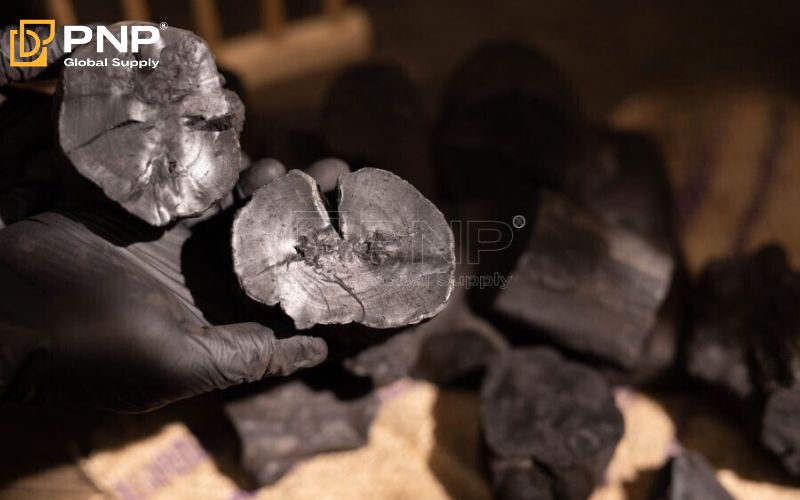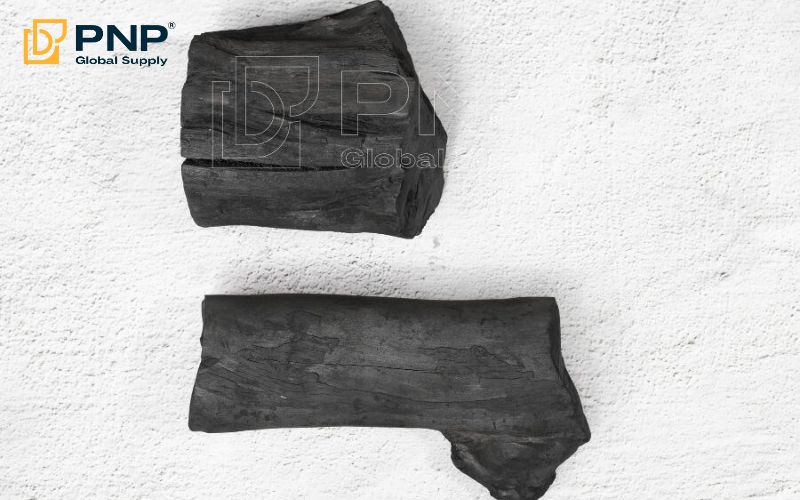Coffee charcoal is easy to ignite, stable temperature, no smell or smoke, and white ash. Suitable for BBQ grilling and restaurant. Free samples and OEM services available. Exporting to Iraq, Dubai, Kuwait,…
With high calorific value and a pretty good burning time, Coffee charcoal is considered an ideal option for cooking, grilling, and other applications.
Coffee charcoal produces little to no smoke and odor, protecting our customers from bad odors on clothes after joining BBQ parties.
Explore the appealing features of Coffee Charcoal, an environmentally friendly and sustainable alternative to traditional charcoals. PNP Charcoal leverages the ability of coffee wood to produce higher heat with less smoke. Discover how this innovative product is transforming the grill and heating industry.
Coffee charcoal is a type of charcoal made from coffee tree wood. At PNP Charcoal, we refer to it as Coffee Wood Charcoal to highlight its unique qualities. Unlike regular charcoal, coffee wood charcoal offers a distinct smoky aroma that enhances the flavor of grilled foods. It also burns cleaner and hotter, making it a preferred choice for professional grillers and eco-conscious consumers.

Using wood from coffee for charcoal is a new idea to find better and tastier grilling options. In the past, charcoal was produced from hardwoods, but when sustainability entered the equation, coffee wood was found suitable. PNP Charcoal spearheaded this initiative by using leftovers from the coffee industry to create top-notch yet eco-friendly charcoal. This treatment reduces imaging waste and offers a unique grilling experience that brings to mind coffee’s interesting history and its ubiquity around the world.
Compared to traditional hardwood charcoal, coffee wood charcoal offers significant health advantages:
The shift to coffee-based charcoal contributes to environmental conservation in multiple ways:

One of the most remarkable properties of coffee charcoal is its exceptional adsorption capability:
The production of coffee wood charcoal aligns with modern circular economy principles, emphasizing resource optimization:
At PNP Charcoal, we pioneered the use of coffee wood in charcoal production, transforming coffee industry byproducts into high-quality, eco-friendly fuel.


This method not only provides an eco-friendly alternative to traditional charcoal but also contributes to waste reduction and environmental sustainability.
| Feature | Coffee Charcoal | Coconut Charcoal |
| Burn Time | 3 – 3.5 hours | 3 – 3.5 hours |
| Heat Efficiency | High, steady heat | Very high |
| Smoke Emission | Low | Ultra-low |
| Eco-Friendliness | Recycled from coffee wood discarded after the harvest season | Made from coconut shells, highly sustainable |
| Best Uses | BBQ grilling, air purification, water filtration | Hookah, shisha, BBQ |
Coffee charcoal is a sustainable, high-heat, and low-smoke alternative, making it ideal for BBQ grilling, air purification, and water filtration. It offers consistent burn performance while being eco-friendly. For a clean, efficient, and sustainable charcoal option, coffee charcoal is a top choice!

Coffee charcoal is also processed into white charcoal (Binchotan), a high-quality form of charcoal known for its high carbon content, long burn time, and superior heat retention. The production process involves an additional high-temperature firing and rapid cooling with ash, resulting in an ultra-dense, hardwood-like charcoal.
The scientific literature on coffee charcoal investigates its working potential and usage areas. Studies are available about its potential to work as an environmental cleaning material for water and soil purification. Researchers are also concerned with the possible health effects of coffee charcoal on the digestive process and food assimilation through its reduction of stomach problems.
With the increasing need for sustainable and clean-burning fuels, coffee charcoal is gaining attention as an eco-friendly alternative. Made from coffee wood, it aligns with global efforts to promote renewable energy sources and reduce environmental impact. Its versatility in BBQ grilling, air purification, and skincare presents valuable opportunities across multiple industries, contributing to market growth.
The increasing use of coffee charcoal reflects a growing awareness of its diverse applications and benefits. Consumers and industries alike are incorporating coffee charcoal into cooking, filtration systems, and beauty products due to its sustainability, efficiency, and low environmental footprint. As more businesses and consumers seek greener alternatives, coffee charcoal continues to emerge as a preferred choice for eco-conscious solutions.

Key markets identified for coffee charcoal include food and drink, beauty and personal care, and environmental uses. In the area of food and drinks, even high-end restaurants and gourmet kitchens offer important growing opportunities as chefs explore new ingredients and techniques to push their art forward. The beauty and personal care industry offers such great prospects because there is a growing demand by consumers for natural and sustainable skincare products, and this has heightened demand for coffee-charcoal-based formulations.

With the increased versatility of the product and interest in sustainable practices, the prospects for coffee charcoal are promising. With more industrial innovations, it is bound to become important in various uses, from the culinary arts to environmental solutions. In further developments, it could be that there will be more improvements in its usage, such as better methods of incorporating it into products or perhaps improved techniques for extracting the maximum benefit from it.

One such tip to minimize environmental harm is to encourage sustainably the use of coffee charcoal to get the most out of it. It advocates for ways of using coffee charcoal in coffee production in ways that reduce waste and use towards a circular economy. Awareness and creation of viable uses by the industry and consumers help in making these practices better for the environment.
Founded in 2015 in Vietnam, PNP Charcoal has transformed the charcoal industry by producing high-quality Coffee Wood Charcoal while promoting sustainability. Initially focused on logistics, the company has expanded into import-export, global distribution, and customs clearance, leveraging its deep expertise to streamline international trade.
With a team of specialists in charcoal production, logistics, tax, and customs, PNP Charcoal ensures premium-quality products and seamless global operations. Committed to enhancing the global presence of Vietnamese charcoal, PNP prioritizes honesty, professionalism, and precision, fostering trust and reliability in international markets.

As the global demand for eco-friendly fuel alternatives continues to grow, PNP Charcoal remains at the forefront of innovation, offering clean, efficient, and sustainable coffee charcoal solutions. With a strong commitment to quality and environmental responsibility, PNP Charcoal ensures that its production and packaging processes adhere to FSC (Forest Stewardship Council) certification standards, guaranteeing sustainably sourced coffee wood and responsible manufacturing practices.
By prioritizing transparency, premium quality, and international expansion, PNP Charcoal is shaping the future of the charcoal industry. Its certified, high-performance coffee charcoal provides businesses and consumers worldwide with a superior, environmentally responsible grilling solution that meets the highest global standards.
Partner with PNP Charcoal today and experience the future of sustainable energy!
Answer: Coffee Wood Charcoal is made from coffee tree wood, providing a unique smoky flavor and aroma to grilled foods. It burns cleaner and produces less ash compared to traditional charcoal.
Answer: Yes, it’s safe as it emits fewer harmful emissions and meets high safety standards.
Answer: You can contact us via our website or email for ordering information and pricing.
Answer: Yes, our products are certified by [certifying agency], ensuring quality and sustainability.
Answer: Certainly! It’s also used in environmental applications like water purification.
To sum up, Coffee wood charcoal is the ultimate option for people who want a good, premium quality and environmentally friendly alternative in the charcoal market. The exceptional characteristics that are inherent in it due to being made from sustainable coffee wood make it perform better and leave less harm to the natural world than conventional charcoal. As more companies and users focus on sustainability and better product quality, Coffee Wood Charcoal becomes an ideal choice. For anyone looking for high grade Coffee Wood Charcoal, they should get in touch with PNP Charcoal so they can learn about the amazing benefits of this unique type of charcoal.
After receiving the full payment, PNP will do the Telex release immediately.
1. Can I get real images and videos of this charcoal?
We upload various real photos of our products and production process on our social media. Follow us to get updated on our charcoal production activities!
2. What is the source of your raw material?
We are proud to say that our charcoal is sourced from legal wood plants with an FSC® certification, ensuring a consistent, trustworthy, and transparent supply to our valuable customers.
3. How can you maintain your product quality?
In PNP, we always prioritize product quality because that is how we build our prestige. With our professional QA – QC team, every new batch of charcoal is ensured in terms of quality and quantity. Plus, every day we test our freshly made charcoal right at the factory with the sound test!
